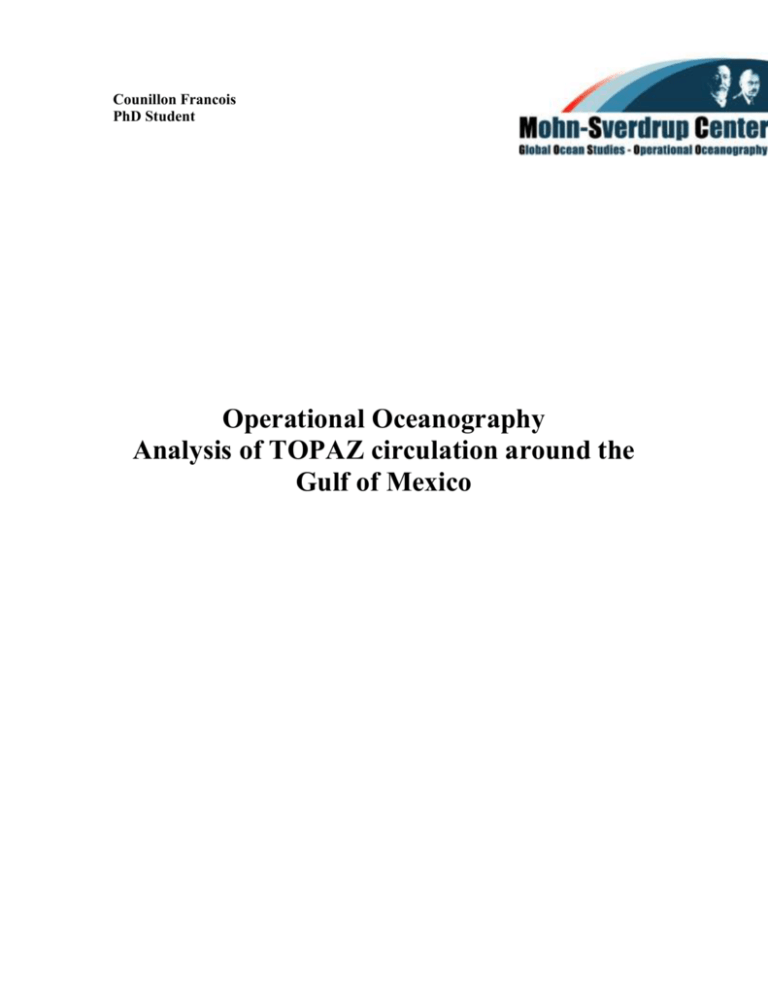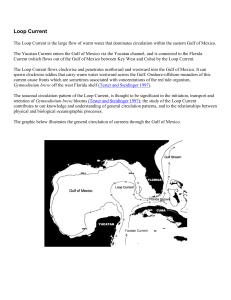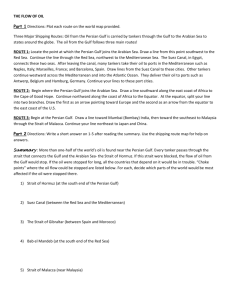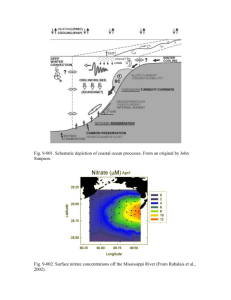Operational Oceanography paper
advertisement

Counillon Francois PhD Student Operational Oceanography Analysis of TOPAZ circulation around the Gulf of Mexico Introduction TOPAZ is a real-time forecasting system that has been established for the Atlantic and the Arctic basin. It uses HYCOM model (Bleck, 2002) with a resolution varying regularly between 18 and 36 km. The TOPAZ system is intended to provide high-quality boundary conditions for nested high-resolution models anywhere in its domain (Gulf of Mexico, Barents Sea, North Sea, western Africa, see fig1). TOPAZ is weekly assimilated using the EnKF (Ensemble Kalman Filter, Evensen 2003). In order to get an efficient operational system we first need to validate the model capability without assimilation, since it will ensure stability of the forecast, and better efficiency in the data assimilation (correlation are found from model realization). This validation work will be applied to the area of the Caribbean Sea and the Gulf Mexico and will focus on the dynamics, the water mass description, and transport verification. We will also analyze the impact of the “quick scheme” on the new TOPAZ system. Fig 1: Topaz model temperature and ice concentration, black boxes represent the implemented nested model. Model Upgrades and Preliminary validation: Since January 2005 an upgrade of TOPAZ has been implemented, it includes: An improved bathymetry, (GEBCO 1’ instead of ETOPO5’) interpolated onto the model grid. (Bentsen et al., 1999) A newer version of HYCOM (from 1.3 to 2.1.03), which improves the description of the bottom pressure, previously zonal and calculates from climatology now. It also presents a better discretization of the equation. Thinner layer for the mixed layer (from 10 m down to 3 m). Preliminary validation work shows that the model presents a better description of the Northern Atlantic dynamics. It shows that a larger amount of Atlantic water comes into the Nordic Seas than in the old version. It has a better description of the complex Brazilian coastal current. In the old TOPAZ version we used a 4th order momentum advection scheme called the Quick scheme (Winther et al. 2005), not yet tested with the new system. (See chap 4) 1. Dynamics The dynamics in the area is dominated by the Guyana Current and the North Equatorial Current (NEC) that are entering into the Caribbean Sea through the Lesser Antilles. The current flows northwestward and becomes the Yucatan Current. It flows into the Gulf of Mexico, a semi-enclosed basin with the colder and fresher Gulf Common Water. The current makes a loop (Loop Current) and exits through the Florida Strait, and in turn it becomes the Gulf Stream. (See fig 2 and 4). Fig3 is a 1 year average of TOPAZ model; we can see all the main currents. The Guyana current and the NEC passing through the Lesser Antilles are well described. As the North equatorial current presents more variability, its signal in SSH has been smoothed out, but I guess that we can see it with the meanders in the north of the Guyana Current. The cyclonic circulation in the Colombian Basin is present. In the Gulf of Mexico, we get a good description of the Loop Current life cycle; the Loop Current grows until it reaches a maximum northern penetration. Then it bends into an unstable position and sheds a warm anticyclonic eddy, which drifts westward. During the period of study (20 months), we observed 2 eddy shedding events, the first one after 6.2 months and the second after 8.6 months. Sturges et al. (2000) found an eddy shedding average period of 9.6 months with high frequencies at 6 and 13 months. Schmitz (2003) presented 3 different pathways used by eddies during their westward drift. In our model run the first eddy used the “central path” and the second the “Northern path”. Our collection of eddy shedding events is, of course, too small to be conclusive but still, this result looks encouraging. TOPAZ also describes the shelf current in the Gulf of Mexico, which is mainly influenced by the wind (green arrow on fig 4). As no model is perfect, we can see that TOPAZ shows wrong unrealistic such as static eddies in the Gulf Stream, which induces an overshoot. These static eddies have already been found in the previous TOPAZ system and in many other models. Fig 2: Circulation describes by Duncan (1982) Fig 3: 1-year average SSH and currents Fig 4: Circulation in the Gulf of Mexico 2. Water masses There are 5 different types of water in the Gulf of Mexico: •Subtropical Underwater (SUW, 36.6 psu, 22.5°C) •Gulf Common Water (GCW, 36.4 psu, 22.5°C) •Antarctic Intermediate Water (AAIW, <34.9 psu, 5.7 °C) •North Atlantic Deep Water (NADW, 34.96, 4.2 °C) •Fresh water from the Mississippi, and other rivers. The Yucatan strait is the best place to compare the water masses in the Gulf of Mexico since it corresponds to the inflow into the basin (except fresh water) and since a lot of measurements has been done there. We can see that TOPAZ represents very well all the different water masses in the area and they are well located. The SUW flows from the plateau of Yucatan and fresher water is located on the Florida side with a very strong inclination of the isohalines. We can also notice the fresher water in the deepest part of the Yucatan strait well represented by the model Globally TOPAZ places the temperature at good depths, but the bowl shape in the deep part of the section is not found in the measurement, this may be due to the no-slip condition boundary condition. Since the stratification is mainly influence by the salinity, we can consider that Topaz has a good representation of the water masses and then of the baroclinic component of the flow. Fig 5: Section of salinity just north of Yucatan Straits [Nowlin, 1972] Fig 7: Section of temperature in the Yucatan Strait, Sheinbaum (2002) Fig 6: Section of salinity in the Yucatan Straits, 1 year avg. Topaz Black line represents the isopycnes Fig 8: Section of temperature in the Yucatan Strait, 1 year avg Topaz Black line represents the isopycnes Fig 9: Section of velocity along the Yucatan Straits, Sheinbaum (2002) Fig 10: Section of temperature in the Yucatan Strait, 1-year avg Topaz Black line represents the isopycnes We can see from fig 9 and 10, that the currents in TOPAZ are very well described except that the deep return flow along the Cuban side is not present (I guess due to the bathymetry). We even found the small return current close to 200m depths on the Yucatan side. 3. Transport We analyzed the section shows in fig 11.The arrows define the positive direction of the section. From this value we can see that the transport is wrong in the Caribbean and in the Gulf of Mexico. The more surprising result is that the transport of the Gulf Stream agrees with the measurement. We can then suppose that a diversion of the flow occurs in the Caribbean Sea and joins the Gulf Stream just after the Florida Strait. From fig 3 we can see that a small part of the flow retroflects and exit through the Windward Passage. This analyze agrees with the result of table 1, since we got 5 Sv out through the Windward Passage instead of in, which could explain the missing 10 Sv. We can also see that the water is going out through the Old Bahamas passage (calculated from section 3, 2 and 4) instead of in. Fig. 11 map of the section The arrows defines the positive transport Section nbr Name 1 Yucatan 2 Florida 3 Florida 2 4 NW Providence 5 Windward passage 6 Mona passage 7 Lesser Antilles 8=”3-2+4” Old Bahamas channel Net transport +/- std 15.59 +/- 2.18 Sv 15.82 +/- 2.20 Sv 14.60 +/- 1.9 Sv -0.54 +/- 0.29 Sv -5.77 +/- 3.76 Sv 1.70 +/- 0.76 Sv 19.26 +/- 5.2 Sv -1.7 Sv Measured value 24 +/- 3.5 Sv Sources Sheinbaum et al, 2002 25.2 +/- 5.1 Sv Hamilton et al., 2005 31 +/- 3.5 Sv Hamilton et al., 2005 -0.9 +/- 1.33 Sv Hamilton et al., 2005 5.6 Sv John et al, 2002 3 Sv John et al, 2002 21.4Sv John et al, 2002 1.9 +/- 1.7Sv Hamilton et al., 2005 Table 1 Transport 4. Momentum Quick scheme We have made a test using the higher Momentum advection scheme (4th order instead of 2nd). Winther et al. (2005) have shown that the use of the “Quick scheme” improves small scale features almost as doubling the resolution does, even though the CPU time is much lower. In our test run, using the Quick scheme creates a leak of the big static eddies and tends to delete them and reduce the overshoot. The transport calculation agrees perfectly with almost all the measurements done in the area.(no shown here) But the following scenario occurs: the LC grows, the instability grows, and it sheds one eddy immediately followed by a second, which chops-off entirely the LC. Fratantoni et al. (1998) and many others found that cyclonic eddies were responsible for eddy shedding. At the end, the model comes into a stable state where the cyclonic eddies grow infinitely and they avoid the Loop Current growth and so any further possibility of eddy shedding. Different tests showed that the bathymetry was not responsible for this failure and this problem did not occur with a resolution of 5km. Further tests will be made with different viscosity parameters. 5 Bathymetry From fig 11 we can see that there are a lot of differences between the old and the new bathymetries that could explain the reason for the transport weakness. First we found that the end of the Florida Strait was too narrow in the model. It could explain the incorrect transport in the Old Bahamas Channel, and in “Florida 2”, but maybe also the poor transport through the Yucatan Strait. Can only 2 grid cells allow 30 Sv with no slip conditions? The response of the model was that the transport into the Old Bahamas channel decrease by 0.5 Sv but does not reverse as expected. We corrected the bathymetry, in the Caribbean Sea where some accidents (ridge perpendicular to the flow) in the bathymetry could deflect the flow out through the Windward Passage. We don’t know exactly which one of this two correction allows an increase of the transport trough the Yucatan Strait. These corrections increase the transport up to 18 Sv in the Yucatan Straits, which is still too low compared to the 24 Sv observed. They decrease the transport in the Windward Passage down to 2.5 Sv. The correction in the Carrabean Sea was very small but seems to me to help a lot the circulation. It seems to me that more radical correction should be applied there Fig 11: Bathymetry difference in the area of the Florida Strait between the old and new TOPAZ (red is a wet point only in the old version) Conclusion: This validation work shows that the new version of the TOPAZ system describes the water masses and the main flow pattern around the Gulf of Mexico well, but it also shows that the transport was weaker than observed. We found out that the weak transport seems to be resulted from the newly implemented bathymetry. Some corrections have been done to it, which showed an increase of the transport in the TOPAZ model (still not enough). Even if the “Quick scheme” shows the correct transport and improved most of the circulation, it is not possible to include it into TOPAZ model yet, since a severe failure appears in the Gulf of Mexico (the Loop Current disappears). The reason is as yet unknown. References Bentsen, M., G. Evensen, H. Drange, A. Jenkins, 1999: Coordinate transformation on a sphere using conformal mapping, Mon. Weather Rev., 127, 2733-2740 Bleck R., 2002: An Oceanic General Circulation Model framed in Hybrid IsopycnicCartesian Coordinates, Ocean Modeling, 4, 55-88 Ducan C.P., S.G. Schladow, W.G. Williams, 1982: Surface current near the Greater Antilles, Int. Hydrogr.,Rev.,LIX(2),67-78 Evensen G., 2003, The Ensemble Kalman Filter: Theoretical Formulation and Practical Implementation. Ocean Dynamics, 52, 133-151 Fratantoni D.M.,T.N. Lee,G.P. Podesta and F.Muller-Karger, 1998: The influence of the Loop Current perturbations on the formation and evolution of Tortugas eddies in the sourthern Straits of Florida. J. Geophys. Res., 103, 24759-24779 Hamilton P., J.C. Larsen, 2005:Transport through the Straits of Florida. J. Phy. Oceanogr., 35, 308-322 Johns, W.E., T.L. Townsend, D.M. Fratantoni, W.D. Wilson, 2002: On the Atlantic inflow to the Carabbean, Deep-Sea Res.,I,49,211-243 Schmitz W.J., 1996: On World Ocean circulation vol I.. Some global features/North Atlantic Circulation, WHOI, Tech Rep. WHOI-96-03, Woods Hole Oceanogr. Inst., Woods Hole Mass.,141p. Sheinbaum J., Candela J., Badan A., Ochoa J., 2002: Flow structure in the Yucatan Channel. Geophys. Research Letter, 29,0 Sturges W., R. Leben, 2000: Frequency of ring separations from the Loop Current in the Gulf of Mexico. J. Phy. Oceanogr., 23, 250-268. Winther N.G., Y.G. Morel, G. Evensen, 2005: Efficiency of high order numerical schemes for momentum advection, to be submitted.









